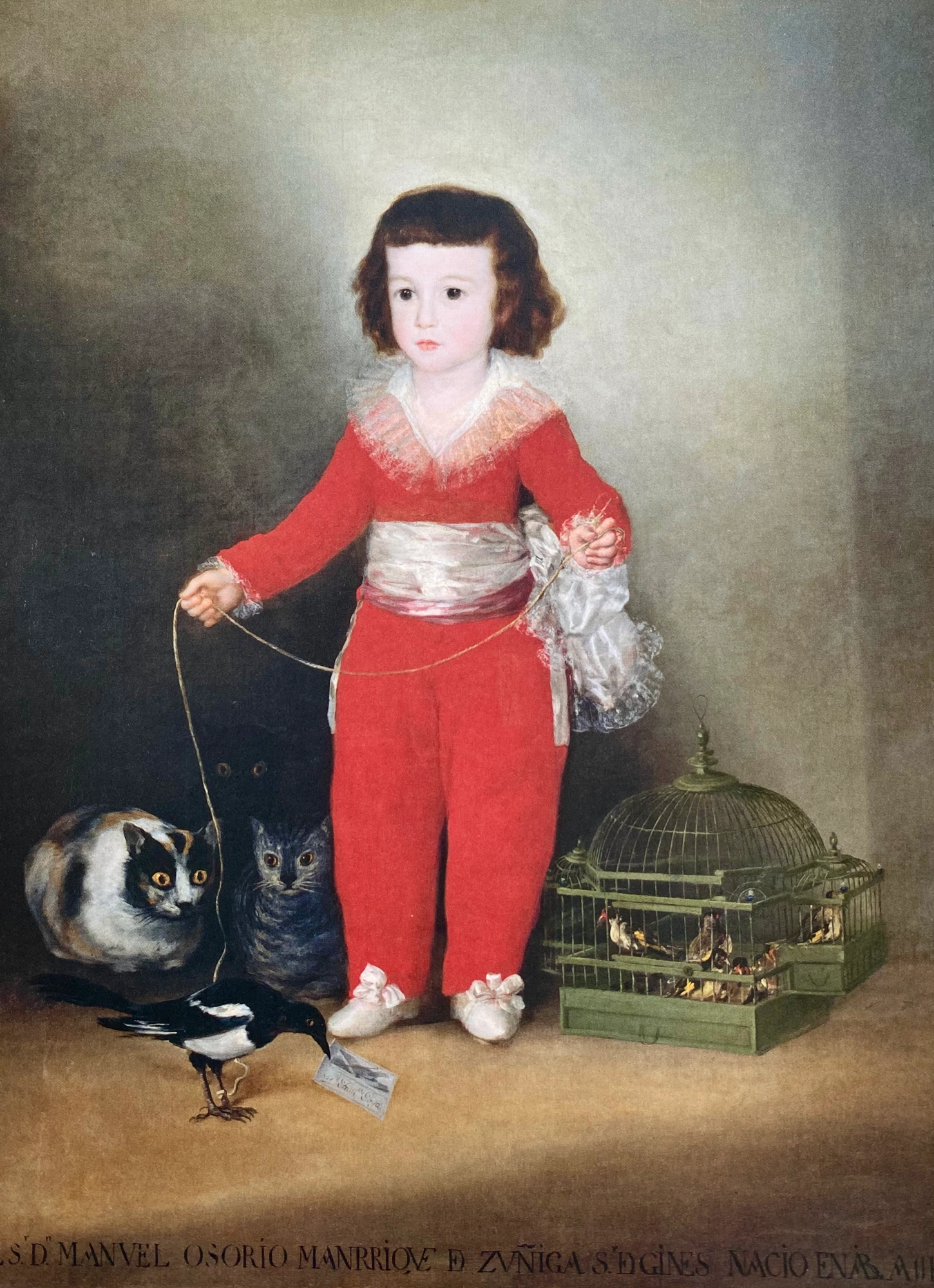Podcast version of this post.
Cat Symbols
There are many stories behind Goya’s painting Manuel Osorio Manrique de Zuñiga. But my favorite focuses on those three cats toward the back. A tabby with swaths of white fur stands out the most on our left. Next to that cat, a grey one skulks with dimmer eyes. There’s a black cat at the back so deep into shadow that we only see its eyes. Goya imbues these felines with meaning in the details.
For instance, the dark cat in shadow represents the mystery of death. While the grey cats lurks nearby, a symbol of this boy’s far away adulthood. The wide-eyed white tabby perches close by… much like the young boy’s adolescence. Sadly, Goya’s Red Boy didn’t make it even to puberty.
The Manuel Osorio Manrique de Zuñiga likeness was one of many Goya did for the boy’s family. Manuel’s father was a Spanish Count who commissioned several such depictions. Goya served as court painter to King Charles III and then Charles IV. He created extraordinary portraits of many people in the royal court. But this one, of the Count’s youngest son, is a masterpiece.
Celebrated Child Portrait
It’s come to represent one of the most celebrated child portraits in art history; even with that challenging name as its title. The little boy’s long name inspired many to shorten this masterpiece’s title to simply Goya’s Red Boy. Though he died at eight years old, the painting’s lasting power isn’t only because of this poignant loss.
This sad fact does permeate the Manuel Osorio Manrique de Zuñiga portrait, though. Goya couldn’t have known this boy would die young, yet we see a painting about the passage of time through the lens of childhood. The cats surround Manuel, lying in wait as his mortality monsters.
That may sound a bit like cat-hating, but Goya has portrayed many ferocious felines. He wasn’t a cat lover and often painted them as monstrous fighters. We don’t need to know this about Goya to see the demon in this trio of felines, though. Just look at the way they ogle the little boy’s bird. These cats can’t help themselves, they’re hungry and this magpie looks like lunch.
LadyKflo’s YouTube Summary
The Irony of Youth
On the boy’s other side there’s a cage of finches. They represent the irony of childhood because they’re trapped and completely controlled by others, yet this also keeps them safe. The cats can’t get to them. Of course, the uncaged bird isn’t completely free either, tethered at the end of Manuel Osorio Manrique de Zuñiga’s string.
The black and white bird has this string tied to his tiny leg. It’s a remarkable depiction because the string seems to glisten in parts, like a line between life and death. We know that line exists but can only experience it when the story’s over. This little boy carries us into the end of that story a bit. Goya portrays him like a saint.
Saints are meant to bring us a piece of the world beyond our everyday reality. They are serious and serene, like Manuel Osorio Manrique de Zuñiga here. He holds his arms outstretched in a gentle, welcoming posture. The rest of his stance reads quite still and resplendent. Never has a little boy seemed quite so overdressed and remote.
From his white satin pointy shoes to the lacy bib beneath his angelic face, this kid is decked out like an involuntary dandy. It’s no wonder he refuses to smile. Cloistered by dark omens, dressed like Louis XIV’s jester, and posing for ages, Manuel felt the pressure and humility of manhood before he’d ever get to enjoy its pleasures.
Manuel Osorio Manrique de Zuñiga – FAQs
What’s the story of the painting Manuel Osorio Manrique de Zuñiga by Goya?
This portrait of little boy red traveled a long road before it landed at the Metropolitan Museum of Art in NYC. It all started when Manuel Osorio Manrique de Zuñiga‘s father commissioned the portrait from Goya. He was the court painter for Charles III and Manuel’s father was a Count.
After living in a Madrid palace until the early 1900s the playwright Henri Bernstein bought the portrait at auction and then based a play on it. Then in 1926 art collector Kathryn Bach Miller fell madly in love with this painting and bought it. But she likely would have said she adopted it… Kathryn loved this masterpiece as if it were her child.
Isn’t a different famous painting called the Red Boy?
Yes. Manuel Osorio Manrique de Zuñiga is sometimes called “Goya’s Red Boy”. But there’s an equally famous portrait by Sir Thomas Lawrence called The Red Boy.
This one’s called Charles William Lambton and Master Lambton as well. Lawrence’s portrait also depicts the young son of political leader dressed in a fancy red outfit. The National Gallery in London bought this Red Boy in 2021 for about $20million. So, it’s making more news these days than Goya’s work.
Enjoyed this analysis of Manuel Osorio Manrique de Zuñiga by Goya?
Check out LadyKflo’s essays on other Spanish masters.
Sources
Rosenberg, Karen. “That Little Lost Boy in Red, Back With His Family”. The New York Times.
Salomon, Xavier F. (2014). “Goya and the Altamira Family”. The Metropolitan Museum of Art Bulletin (Spring 2014).
Behrman, Samuel Nathaniel (1951). Duveen. The Story of the Most Spectacular Art Dealer of All Time
See Manuel Osorio Manrique de Zuñiga at the Met Museum online
Wolf, Riva (2010). “Goya’s ‘Red Boy’: The Making of a Celebrity”. In Schroth, Sarah (ed.). Art in Spain and the Hispanic World: Essays in Honor of Jonathan Brown
National Gallery to acquire Sir Thomas Lawrence’s ‘The Red Boy’ for the Nation, Press Release July 2021
